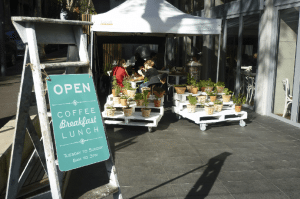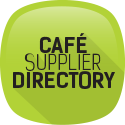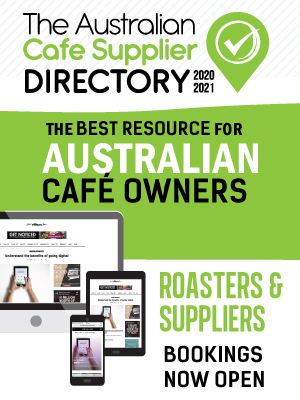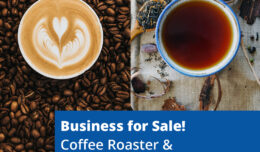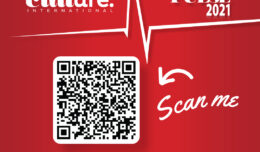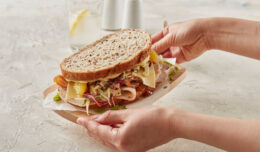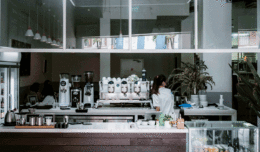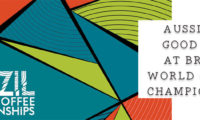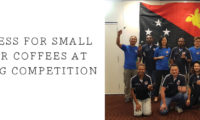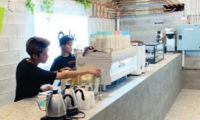Science tells us there are two sides to the brain. There’s the left side, which is more rational, and then there’s the right, which is more emotional. You can imagine a constant internal dialogue, like a parent and child squabbling – don’t do that/but I feel like it – until one side wins.
The Apple iPhone provided consumers with both emotional and rational differences, and that’s why it was such a big category changer. Similarly, a really great café needs to have the right rational and emotional differences to attract the right target market.
This article will discuss aspects of your business that might provide rational differences for the consumer and then some emotional differences. As you’ll see, the two can’t be so easily demarcated, but that’s why it’s so important to get them both right.
Place: the location of your café can be pivotal to its success. Being conveniently positioned on a well-trodden commuter route or on the side of the street that gets the morning sun can’t help but boost sales.
If your café isn’t so well positioned, your store front and signage have to work harder to get people through the door. Of course, outdoor seating may do the same job. Being noticed is important, as it leads to curiosity, and it’s at this point that a customer will make a decision whether to enter your café or not.
Positioning the coffee machine at the front of the store, as it says this coffee purchase will be quick and easy. Additionally, before even entering the café, customers can smell the coffee and see the barista in action.
The design of the seating, especially the choice of outdoor seating, helps your café seem inviting to your target market.
Product: needless to say, your product is the most important factor to the customer, but intelligent design can present it to the best advantage. Well-presented displays should be located as near to the cash register as possible, to encourage impulse purchases, or be displayed in another highly visible location, such as the window or on a communal table.
Often overlooked, the design of the menu helps get the customer excited about your food or drink offering. A badly designed menu with a poor layout, font or paper stock is usually a strong indicator of what’s happening in the kitchen, so you need to make sure these things are done well as they’re a taste of what’s to come, so to speak.
Price: price is a major factor and a category that includes most people these days. Design can’t define the price, but it can help communicate the value.
Breakfast at Orto Trading, a café in the Sydney suburb of Surry Hills, can set you back $30 if you don’t look out, or at least order well. However, the moment you set foot into the light, airy interior with its glorified farm-chic aesthetic, you know you’re in for a quality experience, and you expect to pay a premium for that. You’re paying for the overall experience, so it’s important to make sure the look of your café matches your prices.
People: I was listening to a podcast the other day on Freakonomics. They were talking about Zappos, an online shoe store in the US. The company runs a four-week staff training course and after the first week and every Friday subsequent, potential employees are asked how their week went and told they will be offered $3,000 to leave the company at this point. That’s right, $3000 for leaving.
What does this achieve? It means Zappos’ staff is totally dedicated and committed to their jobs. It makes sense to have trainee employees that aren’t totally committed leave the company as soon as possible, rather than six months down the line, when more time and money has been invested in them. For the record, only 10 per cent of trainees leave the course prematurely, and Zappos considers that value for money.
Basically, the most important people for your business are on your payroll, as it’s service that makes your customers’ experience pleasant. The design of your café can’t improve the quality of your staff, but a good layout and workflow will make it easier for your employees to carry out their jobs. Additionally, a well designed, pleasant working environment, of which design is a key part, can help ensure that your most valued staff don’t leave any time soon.
Now for some emotional factors that can impact on the success of your café.
Trust: in today’s world, where word of mouth travels across the internet like wildfire, one of the most essential things to nurture and build is customer trust.
It’s difficult to establish trust in the café environment, because there’s so many different touch points that can send the house of cards tumbling down – a rude staff member, long waiting times or, worst of all, inconsistent coffee quality.
Trust is built by repeated and consistent engagement and is a direct conduit to purchase and return visitation. The experience begins with their first impression of the café, and the interior, service, price and product need to be of a consistent quality to build consumer trust. The bottom line is that trust takes an enormous effort to gain, but is very easy to lose.
People who are in the trust phase will refer to your business as “my café” or “my morning pick me up”. Your café’s name will always be top of their list of recommendations.
Experience: the café experience incorporates everything from the napkins used to the cleanliness of your bathroom. However, I’d argue that the largest component of this is the look of the interior, which creates an atmosphere that strongly influences the customer experience.
Cafés provide customers with a break from home or work life, and the design needs to appeal to your target market and make them feel comfortable. Surveys have revealed that around 60 per cent of people rate the experience as the second most important factor after the food and coffee when they visit a café .
There is a café I used to frequent, mainly due to its proximity to the Design Portfolio office. The food was great, the coffee wasn’t bad either, but the overall experience was nothing special and there was nothing that encouraged me to linger. This was mainly because the interiors were as bland as a stale cracker, and the general mood of the staff was a real downer.
A new café called St Jude’s opened up on Bourke Street a couple of months ago, and the Design Portfolio staff immediately switched loyalties. Designed by Arthur Koutoulas Design, St Jude – the patron saint of lost causes, in case you wondered – has a great atmosphere with its wrought iron coat hooks running along one wall, Oak chairs and weathered communal table creating a tongue-in-cheek monastery look. Also serving great food, St Jude’s gained a dedicated customer base from day one.
As we can see in these two examples, originality was rewarded, and there’s a danger with standing still. The differences between you and your competition become more apparent. A degree of change is essential, because customers are a fickle bunch – easily bored and distracted by anything new or different. Just ask Darrell Lea.
When giving your business a makeover, you might want to consider one or all of the emotional and rational factors that I’ve mentioned. From a design perspective, it may be a simple as updating the menu or purchasing new outdoor furniture. Essentially, by understanding your customers and the rational and emotional factors that motivate their decisions, you will know which of these “differences’” could ensure you remain their first choice and they stay on your side of the street.
About the author:
Adam Burns is a director of Design Portfolio. Design Portfolio is an award winning company with over 25 years’ experience in retail and hospitality design. They are a multi-disciplinary team that integrate retail design, interior design, industrial design and graphic design to create retail environments that improve your business.
For more information and projects, visit their
website: www.designportfolio.com.au or
call (02) 9439 1106.
Photo credits: Paul Gosney.
Interior Design of St Jude’s
by Arthur Koutoulas Design.


